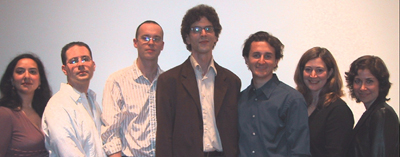Seen and Heard International
Concert Review
Voigt, Birtwistle, Ligeti, Feldman:
Either/Or, Tenri Cultural Institute, New York City, 1
April 2005 (BH)
Steve Voigt: Mercury Mirror (2005, world premiere)
Harrison Birtwistle: Ring a dumb carillon (1964)
György Ligeti: Three Pieces for two Pianos (1976)
Morton Feldman: Why Patterns? (1978)
Either/Or
Anthony Burr, clarinet
Richard Carrick, piano
Al Cerulo, percussion
Jennifer Cobb, soprano
Sandra Noreen, piano
Jane Rigler, flutes
David Shively, percussion

The world premiere of Steve Voigt’s blistering Mercury
Mirror made a sensational opening for the latest concert
by Either/Or, a New York group born in 2003 by Richard
Carrick and David Shively, who are making a splash with superb
programming etched by some the city’s best musicians. Voigt’s
title comes from Cocteau’s film Orpheus, in which
“a giant tub of mercury was used to create the mirror through
which Orpheus passes into the underworld.” The work opens
with a messily invigorating spray of beaten cymbals, but no instrument
is left unscathed, whether bongos, wood blocks, bells or others
– all are hammered within an inch of their lives. Standing
on either side of the long line of percussion instruments, Al
Cerulo and Mr. Shively all but battered them to a metallic pulp.
It may not be a work for the aurally squeamish, but I found it
thrilling.
Next up was an eye-opening Birtwistle piece, also new to me. The
title, Ring a dumb carillon, is extracted from British
poet Christopher Logue’s On a matter of prophecy,
excerpted here:
One slow turn of the world. The cromlech
Whirled once nodding and the buttercups
Ring a dumb carillon of gold in his ear,
Chiming against the twist of the world
A wind-honed prophecy, wake him half
Up to see the moon’s white flotsam.
Birtwistle’s intriguing instrumentation uses bass clarinet
and percussion to accompany an intensely difficult vocal line,
which soprano Jennifer Cobb presented with searing accuracy. As
I’ve said before, I am happy to indulge many interpretive
choices, but have a narrow tolerance for fluctuation in intonation,
and Ms. Cobb just nailed a part that is filled with tricky (and
wide) intervals illuminating Logue’s knotty text. Anthony
Burr was the superb clarinetist, from an all-but-silent opening
to some of the more frenzied outbursts later, and Mr. Shively
as the alert percussionist.
One of the great advantages of this venue, the white-walled, high-ceilinged
Tenri Institute, is the joy of being able to observe musicians
up close – in this case, close enough to notice that the
score to Ligeti’s Three Pieces for Two Pianos seems
to resemble pages from polygraph test results. Pianists Sandra
Brown and Richard Carrick fairly blazed through these superbly
introspective studies, which are typical of the composer’s
trailblazing explorations of timbres and intervals. In the second
(whose title invokes Steve Reich, Terry Riley and Chopin), the
range of pitches is extremely limited, with a long passage using
just five notes in close proximity, rapidly repeated between the
two instruments, producing a buzzing snarl. Notable is the composer’s
use of “ghost” notes, in which the pianist depresses
a key with the left hand, while “playing” it and other
notes on either side. (Ms. Brown confided afterward that it is
actually a bit fatiguing on the fingertips to repeatedly “press”
a key that doesn’t move.) The result of this technique is
twofold: an almost inaudible tapping sound is added to the cloudy
mix, as well as a faint sympathetic vibration from the inner “ghost”
string, its hammer constantly touching it – supremely uncomplicated
ideas producing highly complex results.
I feel lucky to have heard not one, but two performances of Morton
Feldman’s Why Patterns? in the same season. Last
November the New York New Music Ensemble paired it with Grisey’s
wild Vortex Temporum, placing the Feldman first, but
Either/Or used it to end its program, in tranquil contrast
to the nonstop energy in the first half. With Jane Rigler’s
soft pulsing on flute, Mr. Shively’s meticulously placed
glockenspiel strokes and Mr. Carrick’s carefully modulated
piano, the three conjured up Feldman’s trancelike state
with a disarming delicacy.
Tenri is an excellent venue for small events, with a clear and
intimate acoustic and the opportunity to sit just a few feet from
the performers. My eye also wandered, pleasantly, to the current
exhibition called Cursive, by artists D. Dominick Lombardi,
Creighton Michael, David Rubin, Hilda Shen, and Rebecca Smith.
Notes on the evening were included in a beautifully designed printed
program – a narrow booklet enclosed in translucent green
paper. Good design is not essential for a great musical experience,
but in this case it seemed like a subtle hint that this is a hot
new group to watch.
Bruce Hodges
For more information on Either/Or: http://www.richardcarrick.com/eitheror/

